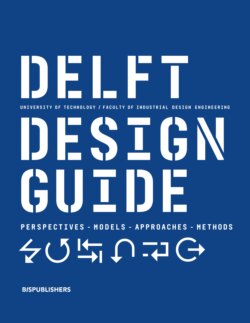Читать книгу Delft Design Guide -Revised edition - Annemiek van Boeijen - Страница 8
На сайте Литреса книга снята с продажи.
ОглавлениеForeword
In the beginning of my career, I had the chance to work alongside the Australian designer Marc Newson on the simple, yet ingenious Ford concept car 021C. This was Marc’s first experience in automotive design. During some of the more intense moments, he described it to me as ‘trying to design 500 products at the same time’.
Cars are incredibly exciting, but also amazingly complex objects. In a way, they are the pinnacle of design in terms of their complexity, impact on society and the way we live our lives. What Marc experienced is daily life for my international design team. About 550 members in 6 studios - from Sao Paulo to Shanghai - are working on 50 to 60 projects at any given time. Which is why I admiringly refer to our team as a creative design machine.
In these projects we work upstream and downstream in close collaboration with market researchers, product planners, engineers, program teams, manufacturing, suppliers, marketing & sales, communication and many other partners. To many people the creative process is very elusive. Design models, approaches and methods help to increase the transparency and timing of the creative process, therefore it facilitates collaboration with the many other disciplines involved.
To do this harmoniously and with a joined understanding of our mission, we use powerful design methods and processes. They are needed to guarantee that our projects address the right future challenges, target the right customers, advance the brand values and progress on time and on budget with the necessary quality while respecting the various rules and regulations.
The car industry is in the midst of a profound transformation towards mobility that is more electric, connected, autonomous, and shared. There is a gradual shift from ownership to mobility as a service, driven by macro-trends such as the growth of metropolitan cities. We search for environmentally responsible solutions while providing freedom of movement and fulfilling people’s wishes to connect. And there is a societal desire to reduce accidents to zero, to improve well-being and give people back their precious time. These once-in-a-lifetime transformations are asking for new solutions. And new solutions need new methods.
Of course, strong design methods don’t guarantee creative and effective solutions. This still depends on the talent, intuition and skill of each individual designer. But the methods provide structure that creates serenity, a space to think, and time to reflect. From my personal experience I know that it takes time to get ‘into the zone’ and to be truly creative.
It is therefore my great pleasure to introduce you to the completely renewed 2 nd edition of the Delft Design Guide. I was not only happy (and a bit relieved) to recognize many of the methods being featured; I also know their value, because we use them on a daily basis. But more importantly, the Delft Design Guide asks stimulating and challenging questions and offers new models and approaches for the reader to try out.
The proposed perspectives, models, approaches, and methods in this Delft Design Guide are what instruments are to a composer; it is perfectly possible to come up with a beautiful melody using only a flute, but why not use the full spectrum of an orchestra and compose a sweeping symphony?
Laurens van den Acker
Executive Vice President Corporate Design Groupe Renault
Graduated at Delft University of Technology, faculty of Industrial Design Engineering in 1990
7
